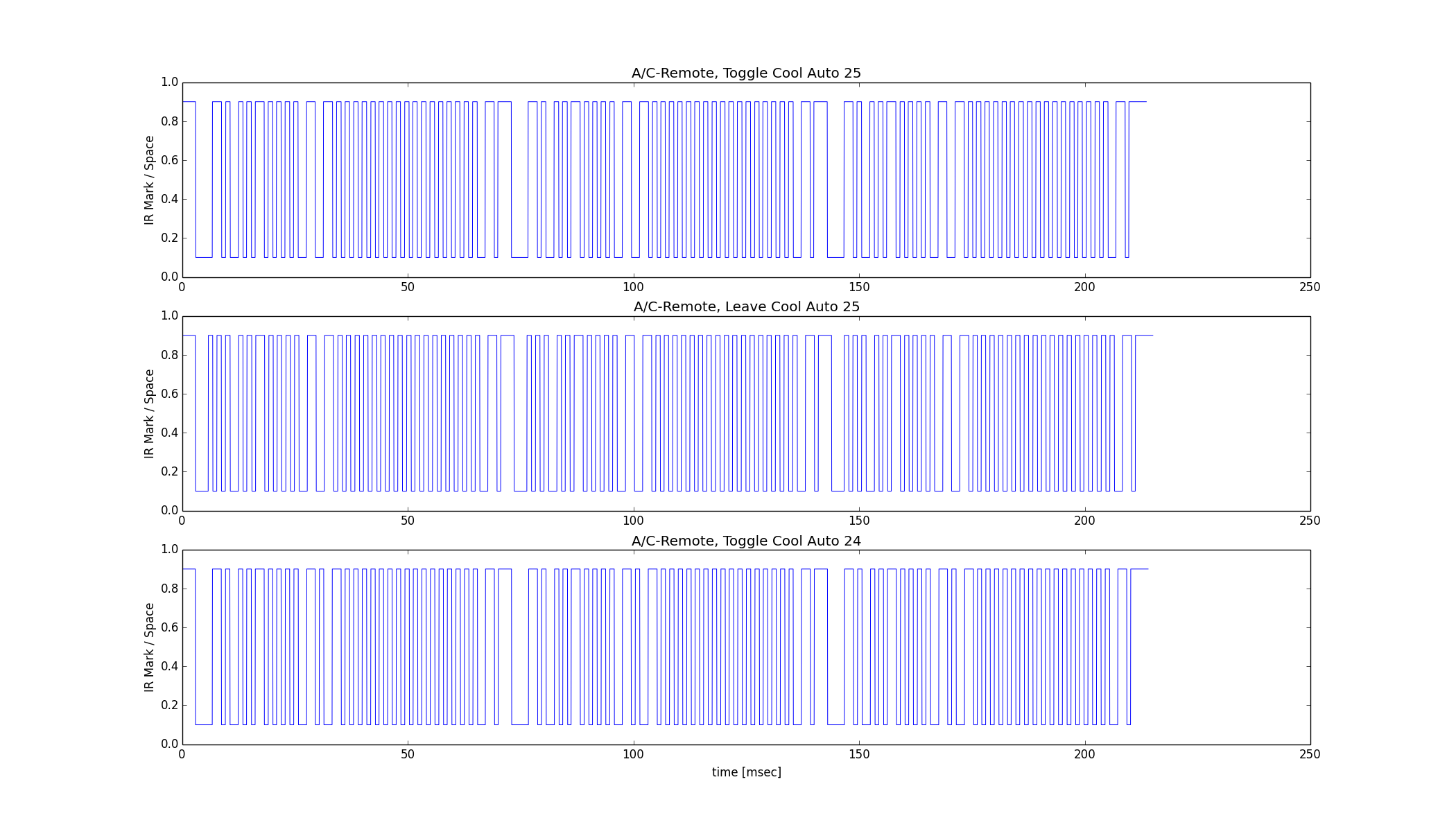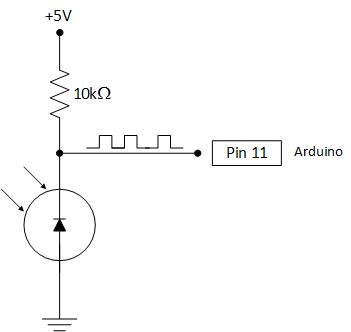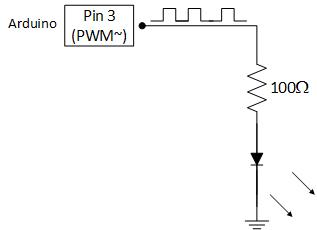home-control-arduino
Arduino projects and Python tools for my home control system.
Arduino IR Receiver
and loading the IRACreceiver project to the Arduino, the Arduino will print to serial raw data on received IR signals, in the form:
0x12345678 (32 bits)
Raw (182): -27866 3050 -3650 2100 -850 1100 -1800 1050 -800 1150 -800 2050 -850 ...
The HEX value is the decoded signal value, and the raw list is a list of IR marks (positive numbers) and spaces (negative numbers) in microseconds - as explained in the [Ken Shirriff's library page] (http://www.righto.com/2009/08/multi-protocol-infrared-remote-library.html).
My A/C is controlled with an IR remote that is not supported and recognized by Ken Shirriff's library. The original Arduino-IRremote library works with up to 100 mark/space buckets, while my A/C remote sends longer signals (around 180-190 buckets), so I forked the library in order to add support for my remote.
In my circuit, I used a simple 38KHz IR Photosransistor.
Arduino A/C IR Sender
and loading the IRACsender project to the Arduino, the Arduino will send (preconfigured) IR signals according to commands received via serial input.
| Command | Description |
|---|---|
S |
Initiate IR transmission of current state (if state not valid - print an error message) |
P0 |
IR signal will toggle A/C power state |
P1 |
IR signal will leave A/C power state as it is |
M0 |
Set A/C mode to Cool |
M1 |
Set A/C mode to Heat |
M2 |
Set A/C mode to Fan |
M3 |
Set A/C mode to Dry |
F0 |
Set A/C fan speed to Auto |
F1 |
Set A/C fan speed to Low |
F2 |
Set A/C fan speed to Medium |
F3 |
Set A/C fan speed to High |
T## |
Set temperature to the 2-digit number "##" |
Feedback
The state-setting commands (P, M, F, and T) echo back with messages "<Parameter-name> parameter set to <new-value>" (or "Invalid <parameter-name> value").
The IR-transmission initiation command (S) reports several status messages:
- "Error in send A/C command - not all parameters set" -- if one of the state parameters was not set to a valid value.
- "Sending A/C command with following parameters: Power=<pwr>, Mode=<mode>, Fan=<fan>, Temperature=<temp>" -- in case the state is valid, before actually transmitting anything.
- "Success" -- if IR signal was sent successfully.
- "Unsupported Command" -- if the current state is valid, but an IR signal for that state is not preconfigured.
In my circuit I used a simple IR LED.
A/C IR Analyzer
The A/C IR Analyzer Python script in the PyTools directory is utility intended to simplify the maintenance of the A/C IR sender project.
As can be seen in the sender code, all preconfigured commands are hard-coded raw buffers representing raw IR signals that can be sent using the Arduino-IRremote library, followed by a "selector" function that returns a pointer to a specific raw buffer that matches the current state (if supported).
This can be hard to maintain manually (e.g. adding additional commands, adjusting the buffers for another A/C, etc.), so I don't :-)
The A/C IR Analyzer Python script takes the output of the Arduino IR Receiver, with some context, and implements two useful subcommands:
- graph -- plots the waveforms of the raw IR samples provided (depends on matplotlib library)
- code -- generates the Arduino code that can be pasted straight into the A/C IR sender project
The output of the Arduino IR Receiver should be given to the script with context on which IR dump represents which A/C command, by passing to the script a path to a directory (using -d path/to/dir flag) that contains raw IR dump files.
Each file should be named following the command it represents, in the form "Power-Mode-Fan-Temp", where:
- Power: "Toggle" or "Leave"
- Mode: "Cool", "Heat", "Fan" or "Dry"
- Fan: "Auto", "Low", "Medium" or "High"
- Temp: A 2-digit temperature value Each raw IR dump file can contain one or more IR samples as received from the Arduino IR Receiver project. The more samples are present in a file, the better the accuracy will be, since the script averages all sampled signals.
Examples of IR Analysis
Graphing signals for 3 commands using python IRAnalysis.py -d test-data/IRdumps graph produces  .
.
Generating code for the same data set using python IRAnalysis.py -d test-data/IRdumps code produces this code snippet:
PROGMEM prog_uint16_t uSendBuff_Toggle_Cool_Auto_25[] = {181, 3000, 3700, 2050, 900, 1050, 1850, 1050, 850, 1100, 850, 2050, 900, 1050, 850, 1050, 900, 1050, 900, 1050, 1850, 1950, 1850, 2050, 850, 1050, 850, 1050, 900, 1050, 900, 1050, 900, 1050, 850, 1050, 900, 1050, 900, 1050, 900, 1050, 850, 1050, 900, 1050, 850, 1050, 900, 1050, 850, 1050, 900, 1050, 900, 1050, 900, 1050, 1750, 2050, 800, 3000, 3750, 2050, 900, 1050, 1800, 1050, 850, 1100, 800, 2050, 900, 1050, 850, 1050, 900, 1050, 900, 1050, 1800, 2000, 1850, 2050, 900, 1050, 850, 1050, 900, 1050, 900, 1050, 900, 1050, 800, 1050, 900, 1050, 900, 1050, 900, 1050, 850, 1050, 900, 1050, 900, 1050, 900, 1050, 800, 1050, 900, 1050, 900, 1050, 850, 1050, 1750, 2050, 850, 3000, 3750, 2050, 900, 1050, 1850, 1050, 850, 1100, 800, 2050, 900, 1050, 800, 1050, 900, 1050, 900, 1050, 1800, 2000, 1800, 2050, 900, 1050, 800, 1050, 900, 1050, 900, 1050, 900, 1050, 850, 1050, 900, 1050, 850, 1050, 900, 1050, 850, 1050, 900, 1050, 900, 1050, 900, 1050, 850, 1050, 900, 1050, 900, 1050, 900, 1050, 1750, 2050, 850, 3950};
PROGMEM prog_uint16_t uSendBuff_Leave_Cool_Auto_25[] = {187, 2950, 2850, 1000, 950, 1050, 900, 1050, 1850, 1000, 850, 1100, 850, 2000, 950, 1050, 850, 1000, 950, 1000, 950, 1050, 1850, 1950, 1850, 2000, 950, 1000, 850, 1000, 950, 1000, 950, 1050, 900, 1050, 850, 1000, 950, 1050, 900, 1000, 950, 1000, 850, 1050, 900, 1000, 950, 1000, 950, 1050, 850, 1000, 950, 1050, 900, 1050, 950, 1000, 1800, 2000, 900, 3000, 2850, 1000, 950, 1050, 900, 1000, 1900, 1050, 850, 1050, 900, 2000, 950, 1050, 850, 1000, 950, 1050, 900, 1000, 1900, 2000, 1850, 2000, 950, 1050, 850, 1000, 950, 1050, 950, 1050, 900, 1000, 900, 1050, 900, 1000, 950, 1000, 950, 1050, 850, 1000, 950, 1000, 950, 1050, 900, 1000, 900, 1050, 950, 1050, 900, 1000, 950, 1000, 1800, 2000, 900, 3000, 2850, 1050, 900, 1000, 950, 1000, 1850, 1050, 900, 1050, 900, 2050, 900, 1000, 900, 1050, 900, 1050, 950, 1000, 1900, 1950, 1900, 2050, 900, 1050, 900, 1000, 950, 1050, 900, 1000, 950, 1000, 850, 1050, 950, 1000, 950, 1000, 950, 1050, 850, 1000, 950, 1050, 900, 1050, 950, 1000, 900, 1050, 900, 1000, 950, 1000, 950, 1050, 1800, 2000, 850, 3900};
PROGMEM prog_uint16_t uSendBuff_Toggle_Cool_Auto_24[] = {181, 3000, 3750, 2000, 900, 1050, 1850, 1000, 850, 1100, 850, 2000, 900, 1000, 850, 1000, 900, 1000, 900, 1050, 1850, 1950, 900, 1050, 1850, 2000, 850, 1050, 900, 1000, 900, 1000, 900, 1050, 850, 1000, 900, 1050, 900, 1000, 950, 1000, 850, 1050, 900, 1000, 900, 1000, 900, 1050, 850, 1000, 900, 1000, 900, 1050, 900, 1000, 1800, 2000, 850, 3000, 3750, 2050, 900, 1000, 1850, 1000, 850, 1100, 850, 2000, 900, 1050, 850, 1000, 900, 1000, 900, 1050, 1850, 1950, 900, 1000, 1850, 2000, 850, 1000, 900, 1000, 900, 1050, 900, 1000, 850, 1000, 900, 1000, 950, 1000, 900, 1000, 850, 1000, 900, 1000, 900, 1000, 900, 1000, 850, 1000, 900, 1050, 900, 1000, 950, 1000, 1800, 2000, 850, 2950, 3750, 2000, 950, 1000, 1850, 1000, 900, 1050, 850, 2000, 900, 1000, 850, 1000, 950, 1000, 950, 1000, 1850, 1950, 950, 1000, 1850, 2000, 900, 1000, 950, 1000, 900, 1000, 950, 1000, 850, 1000, 950, 1000, 950, 1000, 900, 1050, 850, 1000, 900, 1000, 900, 1000, 950, 1000, 850, 1050, 900, 1000, 900, 1000, 900, 1000, 1800, 2000, 850, 3900};
prog_uint16_t * getAcSendBuff() {
if ( (Toggle == pwr) && (Cool == mode) &&(Auto == fan) && (25 == temp) ) { return uSendBuff_Toggle_Cool_Auto_25; }
if ( (Leave == pwr) && (Cool == mode) &&(Auto == fan) && (25 == temp) ) { return uSendBuff_Leave_Cool_Auto_25; }
if ( (Toggle == pwr) && (Cool == mode) &&(Auto == fan) && (24 == temp) ) { return uSendBuff_Toggle_Cool_Auto_24; }
return 0;
}Dependencies and Requirements
Obviously, the Arduino IR Receiver and Sender depend on the Arduino-IRremote library (specifically - the version I forked and modified).
The Arduino projects were compiled successfully with Arduino IDE v1.0.5 on my Windows 7 machine, and run successfully on Arduino Uno.
The Python script works with Python 2.7 on my Windows 7 machine, and requires matplotlib for graphing (I had v1.3.0 when testing, but v1.2.1 also worked).

